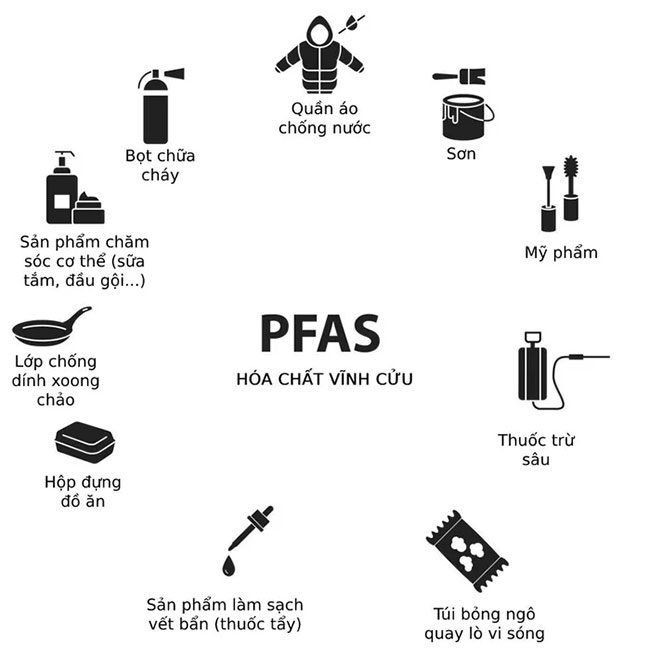Persistent chemicals are used in many consumer products, such as antibacterial agents, pesticides, flame retardants, food additives, and various industrial products. They have been linked to numerous health issues, including impacts on the biological development of children and problems related to diabetes, cardiovascular diseases, cancer, and other health concerns.
“Polyfluoroalkyl substances (PFAS), used in a wide range of household products, are referred to as ‘persistent chemicals’ because they decompose very slowly and accumulate in the environment and in the human body.” Numerous studies have found that these chemicals may increase the risk of certain diseases.
Recently, a study published in the journal Environmental Health Perspectives revealed that exposure to these chemicals may also affect the biological development of children—particularly thyroid function. This is particularly concerning for children.

Persistent chemicals affect children’s thyroid function.
A group of researchers from the Keck School of Medicine at USC found that exposure to a mixture of synthetic PFAS chemicals commonly found in the environment alters several important biological processes (including fat and amino acid metabolism) in both children and adolescents. Disruption of these biological processes is linked to an increased risk of a range of diseases, including developmental disorders, cardiovascular diseases, metabolic diseases, and various types of cancer.
The researchers collected blood samples from two groups of teenagers and children. They found that all children and teenagers had a mixture of several common PFAS in their blood, including PFOS, PFHxS, PFHpS, PFOA, and PFNA. Over 98% of participants also had PFDA in their blood.
The researchers determined that PFAS exposure altered how the body metabolizes lipids and amino acids as well as thyroid hormone levels—a critical determinant of metabolic rate.
PFAS are man-made chemicals used in a wide range of consumer and industrial products. PFAS is a group of synthetic chemicals that includes GenX, PFOS, and PFOA. These are non-biodegradable compounds that have been used since the 1950s in industrial and consumer products, including firefighting foam, metal plating, water/heat-resistant products, stain-resistant fabrics, carpets, non-stick cookware, paints, polishes, waxes, cleaning products, and food packaging.

The researchers focused on children and adolescents because they are undergoing critical developmental stages and may be more susceptible to health impacts from PFAS exposure. This is also the period when many serious diseases in adults begin to “take root.” The researchers added that these findings align with previous studies indicating that childhood exposure to PFAS may increase the risk of metabolic disorders and cardiovascular diseases later in life.
Another significant finding of the study is that exposure to PFAS affects thyroid hormone function.
“Our findings have broad implications for policymakers trying to mitigate risks. We found that exposure to a combination of PFAS not only disrupts lipid and amino acid metabolism but also alters thyroid hormone function,” said Jesse Goodrich, the lead author of the study.
The thyroid plays a crucial role in growth and metabolism. According to Goodrich, the impact of PFAS exposure on thyroid hormone function is surprising and critically important for growth and metabolism. Thyroid hormones are essential for the development of children during puberty and are vital for the growth and maturation of many target tissues, including the brain and skeleton. Disruption of thyroid function could potentially increase the risk of developing diabetes, cardiovascular diseases, and cancer in children.
PFAS are Ubiquitous and Hazardous
In May 2022, according to information reported by The Guardian, a study by the nonprofit organization Silent Spring Institute (SSI – USA) found “persistent chemicals” in nearly 60% of “waterproof” or “stain-resistant” children’s clothing. This organization discovered PFAS—a group of over 9,000 compounds— in clothing, pillow covers, bedding, and furniture, some labeled as “eco-friendly.”
PFAS in clothing can enter the human body through various pathways. They are volatile, which means they can separate from the product, linger in the air, and be inhaled into the lungs. They can also adhere to dust or be absorbed through the skin, and they are present in many environments such as water, soil, air, food, household materials, or workplaces.
“Most of the approximately 4,700 PFAS chemicals have yet to be studied for their long-term health effects,” said Laurel Schaider, an environmental chemist at the nonprofit Silent Spring Institute.

PFAS in clothing can enter the human body through various pathways.
The Centers for Disease Control and Prevention (CDC) states that 98% of Americans have a small amount of PFAS in their bodies and it can take anywhere from 3 days to 9 years to metabolize this amount. Unfortunately, there is no easy way to determine the level of exposure.
The Silent Spring Institute notes that consumers find it difficult to avoid “persistent chemicals” because they are not specifically listed. However, they can often be identified as most “stain-resistant” products typically contain PFAS.
Recently, the European Union (EU) began reviewing proposals to ban “persistent chemicals” (PFAS) due to the hazards they present. In a joint statement, five countries—Germany, the Netherlands, Denmark, Sweden, and Norway—indicated they had been collaborating to draft the proposal. These countries emphasized that the PFAS ban would reduce PFAS levels in the environment over the long term while creating safer products and processes for people.


















































